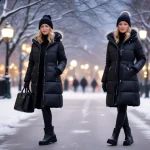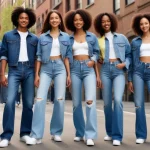Winter Coat Guide: Style & Fit for January 2025
Finding the perfect winter coat for January 2025 involves balancing warmth, style, and fit, ensuring you remain comfortable and fashionable throughout the season.
As the crisp air of January 2025 settles in, the quest for the ultimate winter coat guide becomes paramount for anyone looking to brave the cold while maintaining impeccable style. It’s more than just a garment; it’s a statement, a shield against the elements, and a crucial component of your seasonal wardrobe. This guide is designed to help you navigate the myriad of options and make an informed choice that perfectly blends functionality with fashion.
Understanding the Essentials of Winter Coat Selection
Choosing a winter coat isn’t merely about picking a color or a brand; it’s a strategic decision that impacts your comfort, warmth, and overall style for months. The right coat will be a reliable companion through snow, wind, and bitter cold, while the wrong one can leave you shivering and regretting your purchase. We delve into the foundational elements that define a truly exceptional winter coat.
Beyond aesthetics, a coat’s construction and materials play a pivotal role in its performance. Understanding these aspects allows you to prioritize features that align with your specific climate and lifestyle needs, ensuring your investment is both practical and stylish.
Material Matters: Insulation and Outer Shells
The core of any effective winter coat lies in its materials. Insulation is what keeps you warm, trapping body heat and preventing cold air from penetrating. Outer shells, on the other hand, provide protection against wind, snow, and rain.
- Down Fill: Renowned for its superior warmth-to-weight ratio, down is an excellent insulator. Look for high fill power (e.g., 600-800) for optimal warmth.
- Synthetic Insulation: A great alternative to down, often more affordable and performs better when wet. Primaloft and Thinsulate are popular synthetic options.
- Wool: Naturally warm, durable, and breathable, wool coats offer classic style and excellent thermal regulation.
- Waterproof/Water-Resistant Shells: Materials like Gore-Tex or DWR (Durable Water Repellent) finishes are crucial for protection against moisture.
Construction and Features for Optimal Warmth
A coat’s design elements contribute significantly to its ability to keep you warm. Thoughtful construction can make a substantial difference in comfort during harsh winter conditions.
Consider features such as sealed seams, which prevent water from seeping through stitching, and adjustable cuffs or drawstrings at the hem, which help seal out drafts. A good hood, preferably insulated and adjustable, is also essential for protecting your head and neck from the elements.
In conclusion, a thorough understanding of materials and construction is the first step in selecting a winter coat that truly serves its purpose. Prioritizing quality insulation and protective outer shells ensures you remain warm and dry, regardless of what January 2025 throws your way.
Navigating Styles: From Classic to Contemporary
The world of winter coats is vast, offering a rich tapestry of styles to suit every taste and occasion. From timeless classics that exude sophistication to modern designs that embrace utility and trend, there’s a perfect match for everyone. Your choice of style often reflects your personal aesthetic and the typical settings in which you’ll wear the coat.
It’s important to consider versatility; a coat that can transition seamlessly from a casual weekend outing to a more formal event offers greater value. The key is to find a style that not only appeals to you but also complements your existing wardrobe and lifestyle.
Timeless Silhouettes: Enduring Elegance
Certain coat styles have stood the test of time, proving their enduring appeal and adaptability. These pieces often become wardrobe staples, transcending fleeting trends.
- The Peacoat: A naval classic, characterized by its double-breasted front and wide lapels. Ideal for smart-casual wear, offering both warmth and a sharp silhouette.
- The Trench Coat (Winterized): While traditionally lighter, winter versions with removable linings or heavier fabrics provide excellent protection against wind and rain, maintaining its iconic, sophisticated look.
- The Parka: Originally designed for cold Arctic climates, modern parkas offer exceptional warmth with a rugged yet stylish appeal, often featuring fur-lined hoods.
These classic styles provide a solid foundation for any winter wardrobe, offering reliable warmth and a consistently fashionable appearance. They are investments that pay off season after season.
Modern Interpretations: Function Meets Fashion
Contemporary winter coat designs often blend innovative materials with current fashion sensibilities, offering fresh alternatives to traditional styles. These coats frequently incorporate technical features for enhanced performance.
Think about puffer coats with unique quilting patterns, or sleek, minimalist designs that prioritize clean lines and understated elegance. The integration of smart technology, such as heated elements or built-in tech pockets, is also becoming more common, catering to the demands of modern life.
In summary, whether you lean towards the enduring elegance of a classic or the cutting-edge appeal of a contemporary design, the array of styles available ensures that you can find a winter coat that perfectly articulates your personal style while providing essential warmth and protection for January 2025.
The Art of Fitting: Ensuring Comfort and Style
A perfectly fitted winter coat is transformative. It not only enhances your silhouette but also maximizes warmth and comfort. A coat that is too tight restricts movement and layering, while one that is too loose can look sloppy and allow cold air to seep in. Achieving the right fit is a delicate balance, and it’s a crucial step in ensuring your winter coat performs as it should.
The fit should accommodate your typical winter layering without feeling bulky or constrained. This means trying on coats with the type of clothing you’d usually wear underneath, such as a sweater or a blazer. Pay close attention to key areas like the shoulders, chest, and arm length.
Key Fit Indicators for Men’s Coats
For men, the fit of a winter coat often dictates its overall appearance and how well it complements your frame. A well-fitted coat should project a sense of confidence and polish.
- Shoulders: The seam should align with your natural shoulder line, or slightly beyond if you plan for heavy layering.
- Chest: You should be able to comfortably button or zip the coat with a sweater underneath, without feeling any pulling or tightness.
- Sleeve Length: Sleeves should end at your wrist bone, allowing enough room for gloves or to cover the cuffs of your shirt.
- Overall Length: This varies by style, but generally, a coat should cover your blazer or suit jacket if worn over formal attire. For casual wear, length can be shorter.
Key Fit Indicators for Women’s Coats
For women, the fit can range from tailored and structured to oversized and relaxed, depending on the desired aesthetic. However, comfort and functionality remain paramount.
Consider how the coat drapes over your body. Does it create a flattering line? Can you move freely without feeling restricted? The waistline, if applicable, should sit comfortably and accentuate your shape without being too tight. For longer coats, ensure the hemline is appropriate for your height and preferred footwear.
In conclusion, investing time in finding the correct fit for your winter coat is as important as choosing the style and material. A properly fitted coat ensures maximum warmth, unrestricted movement, and a sophisticated appearance, making your January 2025 winter experience far more enjoyable.
Practical Considerations for Different Lifestyles
Your lifestyle profoundly influences the type of winter coat that will best serve you. A coat for daily urban commuting will have different requirements than one for weekend outdoor adventures or formal business settings. Tailoring your choice to your daily activities ensures maximum utility and satisfaction.
Think about how you spend most of your time during the colder months. Do you walk a lot? Drive? Take public transport? Are you frequently outdoors for extended periods, or do you mostly move between heated indoor spaces? These questions help narrow down the ideal features and durability you’ll need.
Urban Commuter Coats: Blending Style and Durability
For those navigating city streets and public transportation, a winter coat needs to be both stylish and practical, capable of withstanding daily wear and tear.
- Weather Protection: Look for waterproof or highly water-resistant outer shells to combat rain and slush.
- Mobility: A coat that allows for easy movement, especially when sitting or standing on crowded transport.
- Pockets: Ample, secure pockets are essential for carrying essentials like phones, wallets, and keys.
- Layering Compatibility: Should be roomy enough to accommodate a blazer or thick sweater without feeling bulky.
A well-chosen urban coat will protect you from the elements without compromising your professional or personal style, making your daily routine more comfortable and polished.
Outdoor Enthusiast Coats: Performance in Extreme Conditions
If your January 2025 involves significant time outdoors for activities like hiking, skiing, or even just long walks in nature, your coat needs to prioritize performance and extreme weather protection.
Consider technical features such as reinforced stress points, adjustable hoods compatible with helmets, and ventilation zippers for temperature regulation. Durability is key, as these coats will be exposed to harsher conditions. Lightweight yet highly insulating materials are often preferred to minimize bulk while maximizing warmth.
In conclusion, aligning your winter coat choice with your lifestyle ensures that you have a garment that not only looks good but also performs effectively in the specific environments you frequent. This practical approach leads to a more satisfying and functional wardrobe addition for January 2025.
Accessorizing Your Winter Coat: Completing the Look
A winter coat, while a statement piece on its own, truly comes to life when paired with the right accessories. These additions not only enhance your warmth but also provide opportunities to inject personal style and flair into your January 2025 outfits. Thoughtful accessorizing can transform a basic coat into a high-fashion ensemble.
Accessories serve a dual purpose: they offer additional protection against the cold and allow you to express your individuality. From scarves to gloves, each item plays a role in both function and fashion, creating a cohesive and polished winter look.
Scarves: The Versatile Essential
Scarves are perhaps the most versatile and impactful winter accessory. They offer immediate warmth to the neck and chest, and their ability to add color, texture, and pattern is unmatched.
- Material: Wool, cashmere, and alpaca provide superior warmth and softness. Silk can add a touch of elegance for milder days.
- Length and Width: Longer, wider scarves offer more styling options, from simple wraps to elaborate knots.
- Color and Pattern: Choose colors that complement your coat or patterns that add a pop of visual interest.
A well-chosen scarf can instantly elevate your winter coat, adding a layer of sophistication or a playful touch, depending on your mood and the occasion.
Gloves and Hats: Functional Fashion Statements
Keeping your hands and head warm is critical in cold weather, and modern gloves and hats offer both practicality and style. They are essential components of any comprehensive winter ensemble.
For gloves, consider materials like leather for a classic, dressy look, or technical fabrics with touchscreen compatibility for everyday convenience. Hats can range from classic beanies for casual warmth to more structured fedoras or wide-brimmed hats for a fashion-forward statement. The key is to find pieces that not only match your coat but also provide the necessary insulation for your environment.
In conclusion, accessorizing your winter coat is an art form that blends practicality with personal expression. The right scarf, gloves, and hat not only provide essential warmth but also complete your January 2025 winter look, ensuring you step out in style and comfort.
Maintenance and Care for Longevity
Your winter coat is an investment, and like any valuable item, it requires proper care and maintenance to ensure its longevity and continued performance. Neglecting care can lead to reduced warmth, compromised waterproofing, and a diminished appearance. A little effort goes a long way in keeping your coat in prime condition for many winters to come.
Understanding the specific care instructions for your coat’s materials is crucial. Different fabrics and insulations require distinct cleaning methods and storage practices. Always refer to the care label inside your garment before attempting any cleaning or treatment.
General Cleaning and Storage Tips
While specific care varies, some general principles apply to most winter coats, helping to preserve their quality and extend their lifespan.
- Spot Cleaning: Address small stains immediately with a damp cloth and mild soap to prevent them from setting.
- Professional Cleaning: For down-filled or wool coats, professional dry cleaning is often the safest and most effective option.
- Proper Drying: Always air dry coats completely before storing them to prevent mildew and damage to insulation. Avoid direct heat.
- Storage: Store your coat on a sturdy hanger in a cool, dry place. Use a breathable garment bag to protect it from dust and pests during off-season storage.
Addressing Specific Material Needs
Each material has its unique care requirements. For instance, waterproof shells might need periodic re-treatment with a DWR spray to maintain their water repellency. Leather coats benefit from conditioning to keep the material supple and prevent cracking.
Down coats often require specialized washing techniques to prevent clumping of the down, such as using tennis balls in the dryer. Understanding these nuances ensures that each component of your coat receives the appropriate care, maintaining its integrity and performance.
In conclusion, diligent maintenance and proper care are essential for maximizing the lifespan and effectiveness of your winter coat. By following these guidelines, you ensure your chosen style and fit remain a reliable and fashionable shield against the January 2025 chill for many seasons ahead.
Sustainable Choices: Eco-Friendly Winter Coats
As we become more conscious consumers, the demand for sustainable and ethically produced fashion continues to grow. This extends to winter coats, where innovations in materials and manufacturing processes are offering eco-friendly alternatives without compromising on warmth or style. Making a sustainable choice for your January 2025 winter coat is a powerful way to support responsible practices.
Sustainable fashion emphasizes reducing environmental impact, fair labor practices, and circularity in the product lifecycle. When selecting an eco-friendly coat, consider not just the materials but also the brand’s overall commitment to sustainability.
Materials and Manufacturing: A Greener Approach
The core of sustainable winter coats lies in the materials used and how they are processed. Brands are increasingly adopting innovative, environmentally conscious options.
- Recycled Materials: Coats made from recycled polyester (RPET) or recycled wool reduce waste and conserve resources.
- Organic Fabrics: Organic cotton or hemp for shell fabrics reduces pesticide use and water consumption.
- Ethical Down: Look for certifications like the Responsible Down Standard (RDS) to ensure down is sourced ethically, without live-plucking or force-feeding.
- PFC-Free DWR: Per- and polyfluoroalkyl chemicals (PFCs) are harmful to the environment. Opt for coats with PFC-free durable water repellent finishes.
These material choices not only lessen the environmental footprint but often come from brands committed to transparency and ethical production.
Longevity and Repairability: The True Sustainability Factor
Beyond initial material choices, the true sustainability of a winter coat often lies in its durability and the ability to repair it. A coat that lasts many seasons reduces the need for frequent replacements, thus minimizing waste.
Invest in high-quality coats that are built to last. Many sustainable brands also offer repair services or guidance, encouraging consumers to extend the life of their garments rather than discarding them. This circular approach is fundamental to a more sustainable fashion industry.
In conclusion, choosing a sustainable winter coat for January 2025 allows you to make a positive impact while staying warm and stylish. By prioritizing recycled, organic, or ethically sourced materials and supporting brands committed to longevity and repairability, you contribute to a more responsible and eco-conscious fashion future.
| Key Aspect | Brief Description |
|---|---|
| Material & Insulation | Choose down, synthetic, or wool based on warmth needs and climate; consider waterproof shells. |
| Style Selection | Balance classic (peacoat, parka) and contemporary designs to match personal aesthetic and occasion. |
| Perfect Fit | Ensure comfort, layering capacity, and proper shoulder/sleeve alignment for optimal warmth and look. |
| Care & Sustainability | Maintain longevity with proper care; opt for recycled/ethical materials for eco-friendly choices. |
Frequently Asked Questions About Winter Coats
For extreme cold, down-filled parkas with a high fill power (700+) and a waterproof outer shell are generally considered the warmest. Look for features like sealed seams, insulated hoods, and adjustable cuffs to maximize thermal retention and protection against wind and moisture.
Always try on a winter coat with the layers you typically wear underneath. Ensure it allows for comfortable movement across the shoulders and chest, without feeling restrictive. Sleeves should cover your wrists, and the overall length should suit your activity level and style preferences.
Synthetic insulation, like Primaloft or Thinsulate, offers excellent warmth and performs better than down when wet. While down generally has a superior warmth-to-weight ratio, modern synthetics are advanced and often a more affordable, hypoallergenic, and water-resistant alternative for many winter conditions.
The frequency depends on wear and material. For most winter coats, professional cleaning once a season is sufficient. Spot clean minor stains as they occur. Always check the care label for specific instructions, especially for down or wool coats, to ensure proper maintenance and longevity.
Sustainable options include coats made from recycled materials (like recycled polyester or wool), organic fabrics, or ethically sourced down (RDS certified). Look for brands committed to fair labor practices and repair programs. Choosing durable, long-lasting coats also contributes significantly to sustainability by reducing consumption.
Conclusion
Navigating the choices for a winter coat in January 2025 can seem daunting, but with a clear understanding of materials, styles, fit, and practical considerations, you’re well-equipped to make an informed decision. Remember that your winter coat is more than just a garment; it’s a vital piece of your seasonal wardrobe that offers protection, comfort, and an opportunity to express your personal style. By prioritizing quality, fit, and thoughtful accessorizing, you ensure that your investment will serve you well through the coldest months, keeping you warm, stylish, and ready for whatever the winter season brings. Embrace the chill with confidence, knowing you’ve chosen the perfect companion for your winter adventures.




